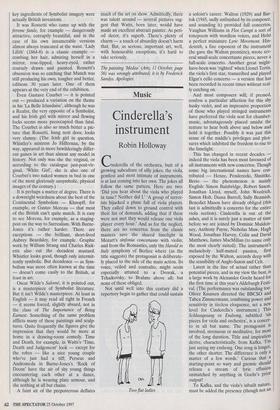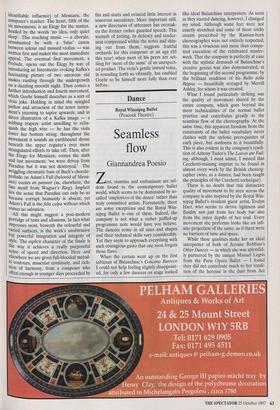Mu sic
Cinderella's instrument
Robin Holloway
Cinderella of the orchestra, butt of a growing subculture of silly jokes, the viola, gentlest and most intimate of instruments, is at last coming into her own. The jokes all follow the same pattern. Here are two: `Did you hear about the viola who played in tune? Neither did I."A group of terror- ists hijacked a plane full of viola players. They called down to ground control with their list of demands, adding that if these were not met they would release one viola player every hour.' And as for the neglect, there are no concertos from the classic masters save the shared limelight in Mozart's sinfonia concertante with violin; and from the Romantics, only the Harold in Italy symphony of Berlioz where (as the title suggests) the protagonist is deliberate- ly placed to the side of the main action. Its voice, veiled and contralto, might seem especially attuned to a Dvorak, a Tchaikovsky, to Brahms above all; but none of these obliged.
Not until well into this century did a repertory begin to gather that could sustain Two flat ladies a soloist's career. Walton (1929) and Bar- tok (1945, sadly unfinished by its composer, and sounding it) provided full concertos, Vaughan Williams in Flos Campi a sort of tonepoem with wordless voices, and Hoist a perfect miniature Lyric Movement. Hin- demith, a fine exponent of the instrument (he gave the Walton premiere), wrote sev- eral small-scale concertante pieces, never a full-scale concerto. Another great might- have-been was 'righted' when Lionel Tertis, the viola's first star, transcribed and played Elgar's cello concerto — a version that has been recorded in recent times without real- ly catching on.
And most composers will, if pressed, confess a particular affection for this shy husky violet, and an impressive proportion of those who played stringed instruments have preferred the viola seat for chamber- music, advantageously placed amidst the texture to hear both above and below and hold it together. Possibly it was just this sense of the middle's privileges and plea- sures which inhibited the freedom to rise to the limelight.
This has changed in recent decades — indeed the viola has been most favoured of all instruments with new concertos. Though some big international names have con- tributed — Henze, Penderecki, Shnittke, Berio — the phenomenon is mainly English: Simon Bainbridge, Robert Saxon, Jonathan Lloyd, myself, John Woolrich, Simon Holt, Diana Burrell, Sally Beamish, Benedict Mason have already obliged (this last is admittedly a concerto for the entire viola section). Cinderella is out of the ashes, and it is surely just a matter of time before we are joined by Dominic Muldon- ney, Anthony Payne, Nicholas Maw, Hugh Wood, Jonathan Harvey, Colin and David Matthews, James MacMillan (to name only the most clearly suited). The instrument's melancholy half-muted passion, first exposed by the Walton, accords deep with the sensibility of Anglo-Saxon and Celt.
Latest in the line of actual rather than potential pieces, and in my view the best, Is a large work by Alexander Goehr heard for the first time at this year's Aldeburgh Festi- val. (The performance was outstanding too: Oliver Knussen directed the BBCSO and Tabea Zimmermann, combining power and sensitivity in tireless eloquence, set a new level for Cinderella's instrument.) This Schlussgesang or Endsong, subtitled 'six pieces for viola and orchestra', is a concer- to in all but name. The protagonist is involved, strenuous or meditative, for most of the long duration. Title and inspiration derive, characteristically, from Kafka. 'I'm just saying my endsong. One song is longer, the other shorter. The difference is only a matter of a few words.' Curious that a starting-point so wary and gnomic should release a stream of lyric effusion unmatched by anything in Goehr's prior output! To Kafka, and the viola's inbuilt nature, must be added the presence (though not an identifiable influence) of Messiaen, the composer's teacher. The heart, fifth of the six movements, is an Elegy for the master, headed by the words 'no idea, only quiet sleep'. This touching music — a chorale, ornamented by with a 'false' canon between soloist and massed violins — was written first and makes the most immediate appeal. The eventual first movement, a Prelude, opens out the Elegy by way of introducing an Intermezzo evoking Kafka's fascinating picture of two amorous old snakes rustling through the undergrowth on a dazzling moonlit night. Then comes a further introduction and fourth movement, which Goehr himself describes as a sort of viola joke. Holding in mind the mingled pathos and attraction of the tenor instru- ment's yearning to aspire upwards, and in direct illustration of a Kafka image — a sobbing trapeze artist unwilling to relin- quish the high wire — he has the viola lower her bottom string: throughout the movement it sounds an earthbound drone beneath the upper register's ever more strangulated efforts to take off. Then, after the Elegy for Messiaen, comes the sixth and last movement; 'we were driven from Paradise but it was not destroyed.' The wriggling chromatic bass of Bach's chorale- prelude on Adam's Fall (beloved of Messi- aen) occurs en passant (as, elsewhere, the fate motif from Wagner's Ring). Implicit lies the sense that Paradise can only be so because corrupt humanity is absent; yet Adam's Fall is the felix culpa without which comes no salvation.
All this might suggest a post-modern Porridge of texts and allusions. In fact what Impresses most, beneath the colourful and varied surfaces, is the work's unobtrusive but powerful integration and integrity of style. The explicit character of the finale is the way it achieves a really purposeful sense of speed and direction. Here and elsewhere we are given full-blooded melod- ic contours, muscular continuity, and rich- ness of harmony, from a composer who often enough in younger days proceeded by fits and starts and evinced little interest in sonorous succulence. More important still, a new directness of utterance has overtak- en the former rather guarded speech. This warmth of feeling, its delicacy and tender- ness compressed within the notes and shin- ing out from them, suggests fruitful orchards for this composer at an age (65 this year) when most of his peers are set- tling for 'more of the same' of an unexpect- ed product. The viola's gentle inward voice, in sounding forth so vibrantly, has enabled Goehr to be himself more fully than ever before.



















































































 Previous page
Previous page